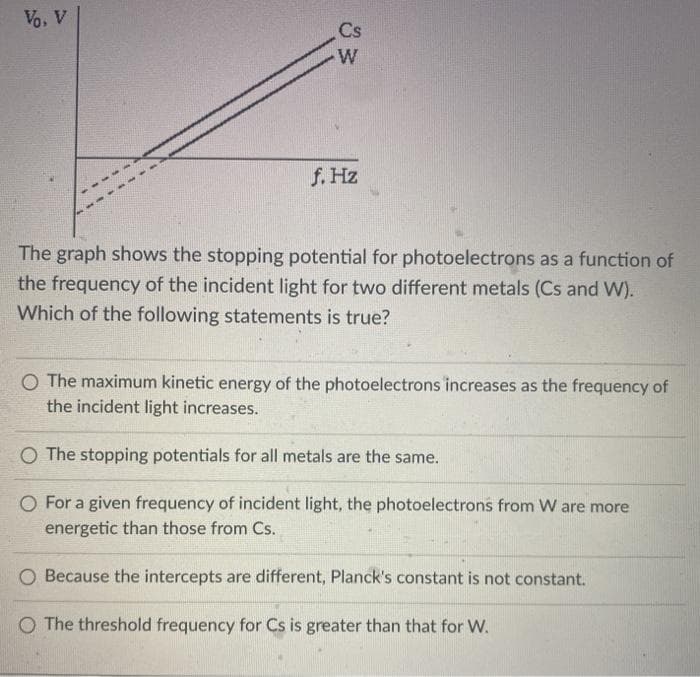Vo, V Cs f. Hz The graph shows the stopping potential for photoelectrons as a function of the frequency of the incident light for two different metals (Cs and W). Which of the following statements is true? O The maximum kinetic energy of the photoelectrons increases as the frequency of the incident light increases. O The stopping potentials for all metals are the same. O For a given frequency of incident light, the photoelectrons from W are more energetic than those from Cs. O Because the intercepts are different, Planck's constant is not constant. O The threshold frequency for Cs is greater than that for W.
Vo, V Cs f. Hz The graph shows the stopping potential for photoelectrons as a function of the frequency of the incident light for two different metals (Cs and W). Which of the following statements is true? O The maximum kinetic energy of the photoelectrons increases as the frequency of the incident light increases. O The stopping potentials for all metals are the same. O For a given frequency of incident light, the photoelectrons from W are more energetic than those from Cs. O Because the intercepts are different, Planck's constant is not constant. O The threshold frequency for Cs is greater than that for W.
Modern Physics
3rd Edition
ISBN:9781111794378
Author:Raymond A. Serway, Clement J. Moses, Curt A. Moyer
Publisher:Raymond A. Serway, Clement J. Moses, Curt A. Moyer
Chapter3: The Quantum Theroy Of Light
Section: Chapter Questions
Problem 43P
Related questions
Question

Transcribed Image Text:Vo, V
Cs
f. Hz
The graph shows the stopping potential for photoelectrons as a function of
the frequency of the incident light for two different metals (Cs and W).
Which of the following statements is true?
O The maximum kinetic energy of the photoelectrons increases as the frequency of
the incident light increases.
O The stopping potentials for all metals are the same.
O For a given frequency of incident light, the photoelectrons from W are more
energetic than those from Cs.
O Because the intercepts are different, Planck's constant is not constant.
O The threshold frequency for Cs is greater than that for W.
Expert Solution
This question has been solved!
Explore an expertly crafted, step-by-step solution for a thorough understanding of key concepts.
This is a popular solution!
Trending now
This is a popular solution!
Step by step
Solved in 3 steps

Knowledge Booster
Learn more about
Need a deep-dive on the concept behind this application? Look no further. Learn more about this topic, physics and related others by exploring similar questions and additional content below.Recommended textbooks for you

Modern Physics
Physics
ISBN:
9781111794378
Author:
Raymond A. Serway, Clement J. Moses, Curt A. Moyer
Publisher:
Cengage Learning

Glencoe Physics: Principles and Problems, Student…
Physics
ISBN:
9780078807213
Author:
Paul W. Zitzewitz
Publisher:
Glencoe/McGraw-Hill

University Physics Volume 3
Physics
ISBN:
9781938168185
Author:
William Moebs, Jeff Sanny
Publisher:
OpenStax

Modern Physics
Physics
ISBN:
9781111794378
Author:
Raymond A. Serway, Clement J. Moses, Curt A. Moyer
Publisher:
Cengage Learning

Glencoe Physics: Principles and Problems, Student…
Physics
ISBN:
9780078807213
Author:
Paul W. Zitzewitz
Publisher:
Glencoe/McGraw-Hill

University Physics Volume 3
Physics
ISBN:
9781938168185
Author:
William Moebs, Jeff Sanny
Publisher:
OpenStax

Physics for Scientists and Engineers with Modern …
Physics
ISBN:
9781337553292
Author:
Raymond A. Serway, John W. Jewett
Publisher:
Cengage Learning

Principles of Physics: A Calculus-Based Text
Physics
ISBN:
9781133104261
Author:
Raymond A. Serway, John W. Jewett
Publisher:
Cengage Learning